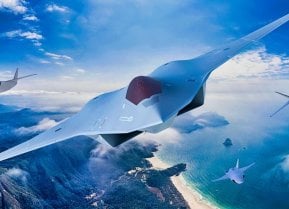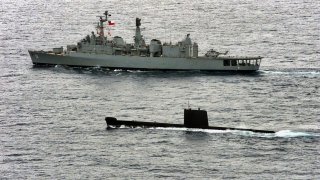A Submarine from Canada 'Sank' A U.S. Navy Aircraft Carrier in a Wargame
Older equipment can't always compete with modern technology. However, the United States Navy has seen its advanced Nimitz-class aircraft carriers defeated by diesel-electric submarines in various war games and exercises.
Summary: Antique small arms and Cold War-era tanks are being used on the battlefield in Ukraine, highlighting the challenges faced by Russian forces. Despite the age of some military hardware, older equipment can't always compete with modern technology. However, the United States Navy has seen its advanced Nimitz-class aircraft carriers defeated by diesel-electric submarines in various war games and exercises.
-These simulations revealed vulnerabilities in carrier strike group defenses, particularly against submarines with air-independent propulsion systems.
-Notably, a Canadian Oberon-class submarine successfully "sank" the USS Dwight D. Eisenhower during a 1981 NATO exercise, showcasing the stealth capabilities of older submarine models.
Stories abound about how antique small arms are being employed on the battlefield in Ukraine, while it is known that Russia has been forced to pull Cold War-era tanks from storage to bolster its forces after suffering significant losses in the more than two-year-long conflict.
However, in most cases – but certainly not all – older military hardware can't compare to the latest and greatest. Yet, as previously reported by this reporter for The National Interest earlier this month, the United States Navy has seen its state-of-the-art Nimitz -class aircraft carriers suffer defeats at the hands of diesel-electric submarines in a number of war games and exercises.
Though these were still in essence simulations and not actual combat, the fact that numerous conventionally powered submarines were able to sneak past a carrier strike group's (CSG's) defenses was seen as extremely worrisome by U.S. Navy officials.
The Antique Canadian Submarine Vs. The Ike Nimitz-Class Aircraft Carrier
Some of the events involving diesel-electric boats and the U.S. Navy's diesel-electric submarines have been well documented, and there are numerous accounts of how Sweden's Gotland-class subs managed to "run circles" around the $6 billion USS Ronald Reagan (CVN-76).
One factor was the submarine's use of an air-independent propulsion (AIP) system, which as reported by Harrison Kass for The National Interest could allow the boat to remain submerged for significantly longer periodsup to two weeks without surfacingcompared to traditional diesel-electric submarines, which must surface within days for oxygen. Equipped with Stirling AIP systems that utilize diesel and liquid oxygen, the Gotland-class can travel 1,700 nautical miles at 5 knots while submerged.
However, a less well-known encounter involved a British-built Oberon-class boat that was in service with the Royal Canadian Navy during a 1981 exercise with the USS Eisenhower (CVN-69). Details have remained sparse on this incident – as no doubt the U.S. Navy didn't want to advertise to the Soviet Union or other potential adversaries that a low-tech diesel-electric submarine could successfully defeat what at the time was one of the newest and most capable capital ships in service in the world.
What is known is that CVN-69 was participating in the NATO exercises Ocean Venture/Magic Sword North, which were the largest exercises in the U.S. Navy's Atlantic Fleet history, while it included Royal Navy, Royal Canadian Navy, and several U.S. Coast Guard vessels.
During Ocean Venture Phase IV, the USS Dwight D. Eisenhower opposed the forces of the Royal Canadian Navy and Canadian Coast Guard, before it took part in a "carrier vs. carrier" engagement with the USS Forrestal (CV-59). CVN-69 then played a supporting role in Magic Sword North by launching simulated strikes into Norway to support allied forces making amphibious landings, after which it rendezvoused with a huge combined force of 19,000 men, 60 ships, and 280 aircraft for Ocean Safari.
In the initial Ocean Venture Phase IV, the pair of carrier strike groups (CSGs) was to transit the North Atlantic and enter the Norwegian Sea, where they would simulate air attacks on enemy positions in waves of coordinated air attacks. However, at some point during the exercise, a Canadian Oberon-class submarine slipped through the escort screen undetected and conducted a successful simulated torpedo attack on the USS Dwight D. Eisenhower. To make matters worse, another Canadian submarine reportedly also "sunk" CV-59 later in the exercise.
The Oberon-class weren't equipped with advanced technology like Sweden's Gotland-class. However, it should be noted that the diesel-electric submarines were still considered arguably the best conventional submarine class of its time. The Oberon-class earned a reputation for remarkable quietness, which enabled them to operate into the late 20th century.
Slow and steady wins the race, but when it comes to sinking a warship, quiet appears to be the way to do it.
Author Experience and Expertise: Peter Suciu
Peter Suciu is a Michigan-based writer. He has contributed to more than four dozen magazines, newspapers, and websites with over 3,200 published pieces over a twenty-year career in journalism. He regularly writes about military hardware, firearms history, cybersecurity, politics, and international affairs. Peter is also a Contributing Writer for Forbes and Clearance Jobs. You can follow him on Twitter: @PeterSuciu. You can email the author: [email protected].
All images are Creative Commons.


